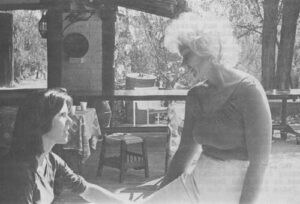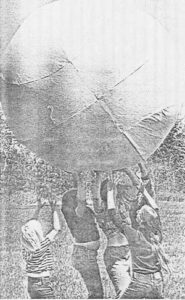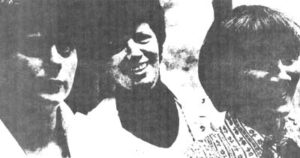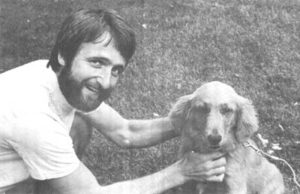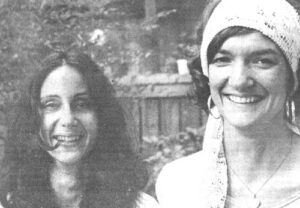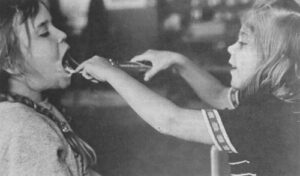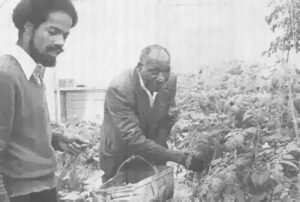We had drunk a finger of wine and now my partner whirled me around the living room of Crosby’s Rest Home to the bouncy beat of Lawrence Welk’s champagne music coming from a tape recorder on the floor. My camera swung from my neck, but I kept up with her. My partner was Alma, in her 70s, a hyper black woman with an intricate dance step that was impossible to follow, yet whatever was going on it was clear that she and the other 17 residents at Crosby’s in Oakland, California were having a laugh.
The wine and music was a highlight of the 1.5 hour program put on twice a week by volunteers from The SAGE (acronym for Senior Actualization and Growth Explorations) Project. SAGE, formed four years ago and now based in the Claremont Hotel, Berkeley, is designed to alter negative attitudes about aging and to demonstrate that people over 60 can grow. SAGE works in four Bay area institutions.
At the start of the program I had been put ff by the smell of urine (it became less noticeable later on) in the home and the apparent immobility of the residents, about seven of whom were sitting there with their eyes closed. You couldn’t be sure whether they were asleep, and our leader Dorothy Ennis, in her 60s told us they know a lot of what is going on. She said before her training started she used to feel herself a failure because so many people were sleeping. “If you reach for all of them you will feel defeated unnecessarily. You have to look for smaller changes. Cecelia used to have her head down the whole time and wouldn’t move when we came here two months ago. She was practically catatonic.”

Today when the group was asked to make fists and punch straight out and say “Pow” Cecelia at least went the first part. She made a fist and held it high on her chest when before she would do nothing.
“That doesn’t happen overnight,” said Ennis. “Now you can kiss her, and she lights up like a beacon.”
The home is all women except for two men. One of them, Ted, 90, is usually talkative but today because of some sleep medication used to keep him from wandering Ted was asleep, his black shoes untied. Two young women interns were distressed to see him so quiet. “He usually loves to dance,” one said.
Ennis spoke at a pre-program pep meeting for the SAGE group prior to going into the living room with the old people. “The best kind of session is spontaneous,” she said. “We use a certain kind of trickery in getting them to exercise without realizing it. By blowing bubbles we get them to take deep breaths and use their legs.”
“The main word is vitalizing which can stir some memories and help to keep their faculties alive,” she said. With her co-leader Bill Love, 64, also a graduate of a SAGE core training group, she planned poetry readings and hymns intermingled with Lawrence Welk. The program got off to an angry start as someone in the SAGE group turned off the TV set and raised the blinds in the dark room.
“Everytime you come here you ruin things,” said a voice hidden behind the corner. It was Florence, a complainer.
“How?” asked Ennis trying to draw her out.
“I didn’t say nothing,” was all Florence would reply.
Love asked if they wouldn’t get together and talk it over. Bessie, 75, the sharpest and most coherent of the group, said nothing was ever right with Florence. She said Florence yelled “bloody murder when someone tried to open the window. Florence says no to everything.”
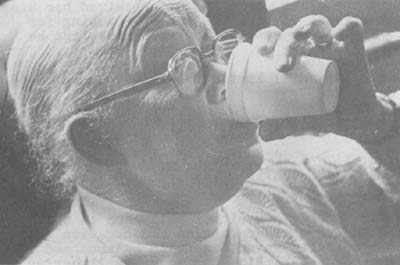
At the end of the program Ennis said it made her angry that Florence had found a way to control the whole group even while remaining hidden behind the corner. Next come exercises and all are asked to sit at the edge of their chairs and get ready to get up, uncrossing their legs to boost circulation. Those who don’t uncross by themselves were coaxed by SAGE volunteers. Some still refused to budge.
Love started to get them to breathe by standing in the center. He lifted his t-shirt and took a big breath. “Make lots of noise when the breath comes out,” Love said.
“You have a cute figure,” said Julia, another woman resident. He had them imitate a hawk flying after a field mouse. I noticed that about eight of the residents didn’t take part in anything. I was discouraged and then I remembered Dorothy Ennis’ words. The dancing comes and goes and I chat with Bessie who tells me “We need to laugh a bit.” Another woman came over holding her false teeth and gesturing to me when she put them in her mouth. They don’t fit, she said. Bessie told her it was because they were upside down and to go away, that I am a reporter not a dentist.
The program over, the SAGE staff adjourned for a post-mortem, mainly focused on giving me tidbits about the program. Love said when he had first started he couldn’t stand the smell and quit. It was only the need that got him back. Marty, an intern, said “We sometimes do massage and the last time we perfumed everybody.”
Once they asked the women during a discussion on sex how they would feel if a man came up to them and said he wanted to have intercourse. Most of them said they would refuse, except for Alma, my dance partner, who said, “I’d say ‘Come and get it.'”
Those who would refuse said they did not miss intercourse. It was kisses, hugs and caresses they longed for.
As we left a woman on the rest home staff was yelling something at Ted, and he didn’t answer. He is deaf. Marty reached out and kissed him on the cheek and said something. It didn’t matter whether he heard the exact words, he had received her kiss. It was my turn to communicate. I took the cue by reaching for his hand. We shook. His watery eyes looked into mine, and he started to say and kept saying:
“I’m still living. I’m still living,” as if he were amazed at the fluke of his surviving.
Sage Spearheads Cultural Change
SAGE’s work ties in with my pursuit of self-care in that it teaches old people how to overcome depression and negative self-image. It teaches them specific ways to move, to balance and to revitalize themselves by deep breathing and specific limbering exercises. Also by the year 2,000, 60 per cent of Americans will be over 60. I’ll be 62. I think about that, and I don’t want to stop growing. It seems to me that SAGE is spearheading some cultural change regarding the segregation of the old.
“The big problem in the United States is this severe segregation of older people,” says SAGE teacher Susan Garfield. “There is this general cultural message that if you pass a certain age–and it’s rapidly dropping–a person is useless. Those old people who can’t see beyond the values of our society incorporate these feelings into themselves, and they feel worthless and isolated, depressed and unhappy.”
Old people in Tibet, China and India and many other parts of the world are revered. Gay Luce, founder and co-director of SAGE, became especially interested in Tibetan attitudes toward old age after taking a program in the Tibetan Buddhist meditation, relaxation and awareness techniques. According to Laughingbird writing in New Age Journal:
“Among Tibetans, old age is regarded as the richest time for inner growth and contemplation–a time for looking over life experiences, sharing them with younger people and preparing for a good death. Gay began to wonder if Tibetan awareness techniques, and other related growth techniques, could be used to counteract our own culture’s terrible neglect and devaluation of the experience of old age.”
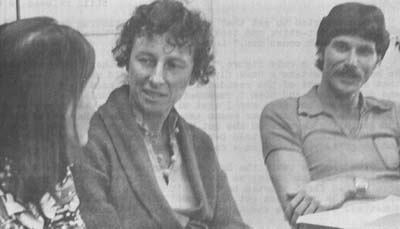
Luce said we have many misconceptions about sleep and the phenomenon of old people waking up so early in the morning.
“This is a universal occurrence. In other countries, such as India, old people get up at 4 or 5 a.m. and go to the ashram for meditation. The early morning is an ideal time to reach the inner self,” said Luce. “But in the United States we consider waking early as ‘insomnia’ and we prescribe dangerous and detrimental drugs to keep our old people asleep.”
(I thought of Ted being drugged to sleep for the SAGE program. What a waste. I guess he was easy to keep track of that way, and besides if he had been wandering off it is hard for rest home personnel who are understaffed to keep track of him).
Breathing and deep relaxation and meditation is stressed at SAGE. Luce meditates about a half hour a day vipassana style which watches what comes into the mind. She says that when she approaches 100 “I would like to be strong enough to move around and take care of myself and I would spend a lot of time meditating, perhaps 4 to 5 hours a day.”
Instead Luce is spending a lot of time concerned with fundraising for SAGE. Though it has a $500,000 grant from the National Institute of Mental Health, none of the grant covers growth, she said, and the organization is hurting for funds and space while daily she gets letters from throughout the country wanting to know where there is another SAGE style program.
SAGE uses a wide variety of techniques to help shake off negativity and to encourage positive action. Among its tools are art therapy, biofeedback, Gestalt dream work, guided imagery, yoga, meditation, music therapy, visualization, breathing therapy and Tai Chi.
“We have found that almost any technique used with love, honesty and real attention will work,” said Ken Dychtwald, a co-director of SAGE. “Techniques are nothing but techniques; it is important to be appropriate…In those first weeks we learned that people had trouble balancing and doing simple things like getting in and out of the bathtub. So we began showing movements that encouraged people to move from left leg to right leg with ease and balance.”
Luce, 47, a psychologist and science writer, known for her books Sleep and Body Time, said, “We teach the elderly how to get out of a chair and how to get down and do exercises on the floor. People are out of touch with their bodies. We try to help them cut out the talk in the back of their heads and give them centering exercises for mental distraction.”
Luce had first begun with the idea of working with children when her 71-year-old mother came to visit her and she switched to working with the old. “We try to help the old be more independent, be able to listen to their own feelings, particularly pain and fear,” said Luce.
She said children between 9 and 13 years old, once trained, could be a wonderful addition to SAGE and could get a lot out of it for themselves.
She said people who go through the initial core group training, as did Bill Love and Dorothy Ennis, end up having different values from their friends. “They know they can alter symptoms,” said Luce. “One woman had migraines and, through breathing and relaxation everyday, she learned how to stop her headaches. She had had them for 15 years. More important she learned self-regulation and listening to the body,” said Luce. “She became autonomous and not a robot.”
Pain and fear are the big bugaboos threatening health, Luce feels. “A person who is dying can be totally healthy, if he is not intimidated by pain and fear,” she said. “The mind is the important thing. Physical symptoms are the last product of disharmony.
For more information on SAGE Project write SAGE at Claremont Office Park, 41 Tunnel Road, Berkeley, CA 94705.
I feel the organization is in the vanguard to help old people avoid being dependent, isolated and depressed. Last September I was encouraged by meeting the sprightly Maggie Kuhn, National convener of the Gray Panthers at a meeting outside Chicago. She deplored the segregation of the elderly, particularly the retirement communities.
The elderly need to learn to protect themselves from worsening balance and from falls. Maggie Lettvin, athletic instructor at Massachusetts Institute of Technology, Cambridge, MA, whose book and TV programs “The Beautiful Machine” have taught many about moving their bodies, teaches elderly how to get up if they fall in the middle of the road or at night and also how to improve their balance and recover movement after strokes.
I went to SAGE because I feel it is working in an area rich for teaching self-care and responsibility and rich for mutual aid groups. Loneliness and depression is often the cause for repeated visits to the medical doctor. There are people who will visit a doctor simply to talk to someone.
SAGE style training, if it could spread throughout the country, could begin to bust the barriers around the old, helping them care for themselves, feel good about themselves and become more independent.
The Alive, the Surviving and the Dying
Dr. Leonard J. Duhl, psychoanalyst turned professor of public health and urban social policy, is fascinated by the division of three types of people in the population–the alive, the surviving and the dying.
I interviewed Duhl, 51, in his office at the University of California at Berkeley. Throughout the hour he illustrated his points with a felt marker on a flip chart accompanied by a tape of his favorite Greek bazooki music as low background. I believe he regards himself as part of the alive group.
The three categories, he explained were arrived at by an Englishman, G. Scott Williamson at the Pioneer Health Centre in Peckham, England. He said that 10 per cent had no illnesses, no pathological findings, no disturbances of behavior and that these are the healthy or alive people.
The second group represented 60 per cent and had disturbances and diagnosable conditions which are not dealt with as illness. They have symptoms. They are the people who adapt, cope with what is. They are the survivors or surviving.
Finally there are the 30 per cent who have illnesses or disturbances which the individual is aware of to the extent of focusing living there. This is illness or dying, partial or full.
“For the dying, health is the balance between illness and themselves,” said Duhl. “For the survivors it is the status quo. They try to get rid of their symptoms. For the alive it is always changing.”
He said that the survivors want to write laws to obtain an absence of disease, while the dying are asking for more resources. “The alive ignore the doctors. The dying are interested in self-care such as colostomy groups and the survivors buy self-help books and try to lower their cholesterol.”
In his papers he wrote, “To survive, where most of us are, is to accept one’s state, to maintain the status quo, to not rock the boat, to be afraid of aliveness and death or illness. To survive is to control others to make them survivors, too….It is the survivors who concern me most…It is they who hold back change.”
He said that when survivors become ill they become alive if they become healed. He discussed healing in “humanized treatment” obeying all doctor’s orders in a nice office or hospital bedroom. “But in healing it is often the person who fights the doctor who gets better. The good patient stays a patient.”
“The alive, when they get sick bounce back fast. They may use aspirin as a crutch or if they’re tense have a drink. Self-healing is not self-treating,” he said. For example he popped a hernia while sailing recently and there was no way he was going to fix that himself. But he said he was a good healer and good at maintaining himself.
His brother Fred, the head of the Boston Family Institute, Boston, MA, had coronary bypass surgery. Had he known of his condition earlier he might have been able to change his lifestyle significantly to make it unnecessary to have the surgery.
Duhl made some quick notes on his pad which distinguished the traditional medical approach from wholism. “Wholism he defined as a way to look at the totality of interactions of the system. He said in medicine there is expertise instead of self-education of the patient. Science and technology replaces touch in medicine. Wholism has mystery while the mystery is gone from medicine, he said. I know some physicians who would disagree with that but what Duhl meant is that through science and tests medicine comes off as if the mystery were gone.”
“Wholism is spiritual, ecological, regards the good patient as one who tells the doctor where to get off, sees healing as coming from within oneself.”
He said there are many persons wholistic in label who use the medical model and deny it. They say one must do X or else all will fail. “They can be in bioenergetics or chiropractic. It doesn’t matter. They are not wholistic. In fact you can have physicians who are wholistic practitioners. Many are.”
I asked Duhl about medical self-care and Dr. Keith Sehnert’s program for activated patients in particular. He sounded scornful. He called Sehnert’s model “illness reduction and not moving toward the ultimate goal which is to maximize growth and development.”
He called for balanced health care involving families, mutual aid, medical systems and backup, environment and police. “You can’t get health if I pollute the atmosphere, and it is not enough for me to ask you to boil water….The Chinese say let 100 flowers bloom. I say let 1000 flowers bloom (in health). It is better to have a lot of programs flourish rather than have health all delivered from one source.”
In the conclusion of a paper, Duhl quoted W. H. Auden:
Healing, Papa would tell me,
is not a science,
But the intuitive art
of wooing nature.”
Duhl ended: “The promotion and maintenance of health is not a myth; since it is so important to be a reality it cannot be left just in the hands of the medical profession.”
Duhl, trained at the Menninger Foundation, has been chief of planning for the National Institute of Mental Health. He has worked at HUD (the Department of Housing and Urban Affairs), with the Peace Corps and the poverty program.
Visualization, Gaits and Zest to Jogging
(Exercise is a part of self-care, and jogging is sweeping the country as a way to stay fit. I learned in California on a weekend running workshop that jogging doesn’t have to be boring that instead it can be meditation, lead one to an altered state of consciousness and bring joy. Here is an account of that weekend).
Five runners galloped down the pasture hill in the morning light while their coach Dyveke (pronounced Durvahkah) Spino shook her fists with delight and excitement, her platinum hair flying.

“Beautiful! Beautiful!” she cried. “Just like animals. Just like ANIMALS.” She drew out the word animals as if to run like an animal were the highest form of running. Prance, shakeup, free-swing and shuffle were some of the other gaits in addition to just plain jogging which Dyveke directed her runners to employ for variety and increased energy. In the gallop the five were swinging their arms over their heads and thrusting their shoulders forward with an abrupt guttural exhalation of sound. If you were an everyday jogger in the park and they came up behind you making that noise, you’d jump. The sound was startling and full of energy.
Across the pasture a handsome chestnut horse raised his head from grazing the brown grass stubble. His nostrils flared and his tail arched apparently responding to the runners’ puffing and blowing.
The running was part of a weekend workshop on advanced fitness, also billed as Re-owning Your Own Power at the Westerbeke Ranch, Sonoma, California, about an hour north of San Francisco in the wine country.
Dyveke, 46, a fitness and tennis coach, concert pianist, and swimmer had worked with the galloping runners individually in past months. They included a rugby-playing investment adviser, a Welsh flautist who ran barefoot, a Sacramento optometrist, a U.S. senator’s former district manager and a book editor.
The editor, Alan Rinzler, 39, of Berkeley, who has been jogging five miles daily, described the run this way: “It was ecstatic. First we went up the hill together keeping in touch with each other’s energy. Then instead of turning around at the top and going back, staying on the path, John (the flautist) led us off the path, galloping downhill freely through the grass. The energy was great.”
I was in the second group of slower runners. I was teamed up with Diane Battung, a 32-year-old teacher from Los Angeles who does yoga. Dyveke told us to exchange energy and keep in touch by sending light streamers through the top of our heads. She told us to prance, stepping like horses with knees high, reminiscent of football and marine exercises. As we went up the hill in the prance I got tired and I allowed my knee action to slacken and drew a call from Dyveke, “More, Philip, more.” But when we returned at a gallop I got a “Good, Philip, good” from her and the approval felt fine.
I had first met Dyveke in the spring when she had mapped out for me a running, swimming and yoga regimen. When I got to the West Coast to research self-care and attend her workshop in Sonoma I had not been following that regimen.
The first night of the weekend she said she had just completed a 10-day water fast at a holistic health center called MeadowLark In Palm Springs. “My pulse is 55, my blood pressure is 95 over 60 and I feel so cleansed. The center is a healing place for cosmic consciousness in the U.S.,” she said.
Dyveke sees herself as a coach of the new age and as someone with untapped psychic resources. Keith Thompson, one of the first runners, 23, said Dyveke coached him on his first marathon. He finished the race in 41/2 hours in Columbus, Ohio, but ran into trouble about the 18 mile mark. Dyveke who was in California at the time reported that her breath stopped for a moment which later checked out to be the time Thompson reached the 18 mile mark.
She has worked with John Lilly, known for his exploration into altered states of consciousness through sensory deprivation tanks as well as his work with dolphins. “I am fascinated by interspecies communication,” she said during introductions the first night. “People should replace their swimming pools with sensory deprivation tanks in which to suspend the body in a saline solution,” she said recalling flying over the swimming pools of the San Francisco Bay area and thinking what would happen to the consciousness of their owners if they all traded their pools for tanks.
Dyveke’s ex-husband, Michael Spino, has also been working on exploring the inner spaces of consciousness during running and has written Beyond Jogging. He writes: “Running offers increased vitality and awareness; it is my yoga…” Dyveke showed movies of the late Olympic coach from Australia Percy Cerutty. The movie showed himself at 80 running in a fluid rhythm with hands down low so that the arms were loose and not tight and clenched in the way we associate runners. Their shoulders were loose.
Dyveke calls herself a “lifestyle fitness coach” which is a mouthful. I am not sure what it means, but it seems that Dyveke wants to coach students in lifestyle, eating, and music and way of living. She concluded her evening remarks by the firelight in the main ranch house by saying that the rock beat is damaging and the cha cha and samba give energy. “I play baroque and Vivaldi in the morning…” she said.
She paused. “Our bodies are like living flames, burning up old cells and becoming new again”…and later her eyes glistened in the light and she said: “I want to play the edges,” meaning, I guess, she wasn’t afraid to take risks. She had said earlier that she feels personally selected to link the holistic health movement from California to Boston and that she is a channel for the new age. She said she has been tutored by Michael Murphy, founder of Esalen Institute, first of the human potential movement growth centers, and George Leonard, former west coast editor of Look magazine, author and Aikido teacher. And she said she feels she is on a mission. She said she had learned that some big oil money had invested in a course on miracles which indicates that money is in innerspace and miracles. When one of the movies she showed mentioned there were three states of consciousness–waking, dreaming and sleeping–she scoffed, no, there were 21, but she didn’t list them.
Next morning before dawn she was banging the triangle shaped gong calling the 17 of us to get out of our bunks and down to the pool for a pre-run stretching workout. She is careful to have joggers stretch well before and after running to avoid injuries. She also asks us to try visualizations, an important tool for her to help runners tap greater reserves in the inner self. Example; imagine a golden tube from your throat to your belly and feel the breath going up and down the tube. Or imagine a white dot between the eyes that evolves into a white sunstar spreading warmth and light within. As she talks I notice she uses such phrases as “flesh vehicle” and “energy system” for body. At first it sounded contrived but then I thought. “Flesh vehicle.” It made it sound as if this flesh of mine were carrying me somewhere and “I” could be inside all parts of it. I decided not to let Dyveke’s language put me off. Her program was playing with the environment. Later I heard that a class of Berkeley students had been turned off by a video presentation by Dyveke because they felt it was too high flown and trying to be too spiritual. I could see how that might happen on video tape but in the field when you had a chance to test out what she was saying it made more sense. As we left the stretching area to run into the hills she urged us to release our eyes, allowing them to be slightly out of focus. “Run with soft eyes,” she said.
It was dawn now and we were running in a circle and then in a snake formation following one another. “We’re making a power center, a psychic ring,” cried Dyveke. “We’re generating energy.”
She had conviction when she spoke and I wanted to believe that I was picking up energy as I gave it. Then when I had begun to get bored with the snake she changed the pace and we broke off into twos and threes running in a fast free swing down a stony road.
She then told us to run wherever we wanted alone in the fields and rolling hills around us. After five minutes running I chose to walk up a hill keeping soft eyes as Dyveke calls it, not staring. I was drawn to a large tree which stuck out for some reason. “Maybe this is a power center,” I said to myself. Dyveke had assured us that there were power centers and psychic rings on the ranch. I approached the tree and stretched my arms around its gnarled cracked black bark and gave it a hug and listened. What was I listening for? A hum? This wasn’t a telephone pole. But it seems as if I felt some sort of energy. Purely the power of suggestion, my brother-in-law the doctor would say. Maybe so, Maybe not.
Dyveke had said that while running she would gain energy from trees and power spots in the forest. The notion sounds full of elves and fairies and nonsense, but I know I left that tree with more energy than I began and spurted up the rest of the hill in a good run. Most of the others had run throughout the half hour respite. But at breakfast I found another walker, Carolyn Sue Podboy of Kenwood, California, a chunky housewife with a warm smile who said when she stopped to walk she burst into tears at the beauty of the hills and the valley.
It was Sunday morning before Dyveke set off to work on holistic health in Boston that the scene occurred with the five runners and the snorting horse. Carolyn Podboy commented quietly that horses didn’t have to be taught how to run with rhythm, they learned from their mothers. Children run naturally too, I thought; it is when they become adults they need help. During the run the second morning I concentrated on the visualization of the golden tube and it helped. The air within me flowed without effort. Dyveke had told us to imagine continuously throwing up heat from the top of the head when pulling grade up a hill. She said that would make the grade easier.
In Creative Running, Tips From a New Age Coach published in New Age magazine Dyveke writes that a new appreciation of the body is one of the first results of starting training in running. “This combined with ensuing weight loss or improved muscle tone, is inextricably woven with enjoying one’s sexuality and developing the ability to manifest one’s dormant capacities in the world…I often see women who feel victimized by overpowering men in their lives take a quantum leap in their level of self expression and career almost immediately, once they physically take charge of disciplining their bodies.” She goes on: “In order to de-emphasize competitive tendencies, take time with your running: using visualizations, get into being where you are running rather than ‘getting there.'”
Here’s what several participants in the weekend workshop thought about Dyveke’s training.
Jerry Mosher, 33, investment adviser from Oakland, had been working with her for less than a year. He is a member of BATS which stands for Bay Area Touring Side (rugby team). He had pulled a hamstring and missed five games. “My body would have broken down in five years if I hadn’t gotten in touch with her. Dyveke was awakening things in me I never thought about and expanded the limits of what I thought I could do, like putting my leg up and out to the side,” he said. He said during the time he had been rolfed and had had chiropractic treatment for alignment. Rolfing–more formally known as Structural Integration–involves ten hours of deep manipulation of the elastic tissue structure (myofascia) of the body in an attempt to improve its equilibrium.
Keith Thompson, 23, recalled using visualizations before he met Dyveke. He recalled running at 5 a.m. and seeing a white dot, which becomes a white band and unfolds into a field until he sees a deer loping there and he “becomes” the deer. “Sen. (William) Proxmire turned me on to running in 1975. Health and physical fitness were my reasons and I started doing three miles and it hurt. I use an Adidas TRX waffle sole (running shoe) and I knew the sidewalks were not a good thing for me. But pastures are idyllic and when I see a bird I realize it is important to move my shoulders up and drop them. Dyveke calls that the shakeup. He said he had got to the point in his marathon “where something beyond me was doing the running. I am more balanced now with less tension.”
David Arant, 42, from Redondo Beach in the Los Angeles area, a human relations teacher at a community college, had met Dyveke at Esalen two years ago. “She is the only person I know who can take physics and mathematics and apply them to the body and to jogging. She takes the mind and body and synthesizes them and makes jogging and hiking and running better. She’s into imagery, and she’s tremendously intuitive. Running is an aspect of her. She feels vibrations.”
In addition to running, the weekend included a look at Moshe Feldenkrais’ body work which concluded with a Tibetan meditation. Bill Callison, leading the session, said the meditation wasn’t spiritual and had no mantras. All you had to do was lie on your back, take your shoes off and move your feet back and forth with smaller and smaller movements. At the conclusion of the meditation it was clear that a certain number of the class of early morning runners had “fallen out” (fallen asleep).
Othon Molina, 27, who had lived with Indian medicine men in Arizona and in a tipi in Oregon for five years, spoke on Indians while we all sat in a circle. “It is Indian prophesy that when the white man’s children grow hair, dress like Indians and live in tipis, it is time to spread the word of Indian lore,” he said.

Shanti Moores said that Rolling Thunder, a Cherokee medicine man has been criticized by other Indians for speaking to large groups of whites. He goes on intuition and sometimes will cancel a speaking engagement if he doesn’t like the vibrations of the crowd. “Snakes are high spirited beings,” she said. “They can absorb evil. It is bad medicine to kill a snake. Rolling Thunder talks to them and at one evening pulled a snake from a pouch.”
Molina told of a healer from Eugene, Oregon, named Louise Fay who worked in polarity therapy. He demonstrated. He had a volunteer lie down on his back and his knees up, with arms on his chest. Molina then sat on him, first on the pelvis and then on the pubic bone. The treatment adjusts the angle of the pelvic bone. The hardest part for the client is to let go and the hardest part for the therapist is to pay attention to the breathing of the client, he said. Molina said he received one of these treatments every two weeks after he was injured by a fall from a horse.
Testing of muscle strength or applied kineseology I had seen demonstrated several times during my travels. Here at the ranch Richard Duree of the Touch of Health Chiropractic Clinic in Pasadena demonstrated among other things that the jumping jack warm-up exercises make muscles weaker despite the fact that athletes commonly use them as warm-ups. He demonstrated with someone by first testing his pectoral muscle trying to push down his outstretched arm. After the jumping jacks he had the person do cross knees touching the opposite arm to the opposite knee. The arm appeared to regain its strength. More tests. Worry and upset and yelling made the volunteer weak. Tapping the forehead made him weak and rubbing it restored strength, running a line from the pubic bone to the mouth brought weakness, reversing the line made it strong again.
Psychic Surgeons of the Philippines
Wendy Westerbeke, manager of the ranch and daughter of the owner, Don Westerbeke, told me how her father came to be so interested in opening his place to groups from the human potential movement. He had a pituitary tumor removed by a Philippine healer in Manila, she said, and it opened up his whole life. “The tumor had been pressing against his optic nerve and blurring his vision,” she said. “He learned of the healers through my mother who had a movie about them. He said he didn’t feel a thing in the operation and that the healer somehow removed the tumor by going through the forehead.” She said he returned to Manila with scientists to investigate the healers and take films.
It was the second time in four days I heard about the healers, often referred to as the psychic surgeons of the Philippines. I was staying with my sister in Oregon when the local United Parcel Service driver, Alan Leach, pulled up to tell me about his experiences in Manila. “The only tools they used were water, cotton balls, and an emesis pan. They washed their hands before each operation and that was it.”

He said a friend and diabetic, Jimmy James, 37, had been operated on in the intestinal area and they removed tissue from his pancreas. They also popped his eyes onto his cheeks to remove scar tissue from behind as he was going blind. On Leach they fixed his hemorrhoids, back pain, eye, tumor in his bladder and calcium deposits on his hips, he said.
The operations were done in one of two rooms of the Bayview Plaza hotel in Manila. Making the journey were 169 persons from Oregon, Washington and Idaho flying on a charter from Portland. Leach spent 15 days there and had 10 appointments. He said the only sanitation was washing hands with no shaving of the area to be worked on. Just tap water was used. A rubdown followed the surgery, a good massage with Chinese ointment, very soothing, and each person was told to rest two hours whether they felt badly or not.
“When I got back I tried to talk to one doctor and an optometrist about it but the doctor didn’t dare believe there is something to it. I don’t think there are any M.D.s who would say there is something to it. Yet there is no scar where they opened the flesh in my throat. I have been trying to find the answer to what happened for the past year and a half…I couldn’t sleep for three days when I returned. I still don’t have the answers, but I believe in it.”
He concluded that the Philippines would be the first place he’d go if he had another serious problem.
Received in New York on December 27, 1977
©1977 Phil Weld, Jr.
Phil Weld, Jr. is an Alicia Patterson Foundation award winner on leave from the Lawrence Eagle-Tribune. His fellowship subject is the role of self-care in health: a look at prevention, patient education and patient power in the U.S. and Canada. This article may be published with credit to Mr. Weld as a Fellow of the Alicia Patterson Foundation and to the Lawrence Eagle-Tribune. The views expressed by the author in this newsletter are not necessarily the views of the Foundation.

